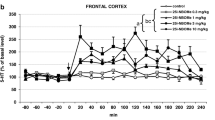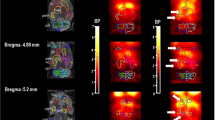Abstract
The aim of the present study was to further investigate the behavioural and biochemical pharmacology of the directly acting dopamine (DA) receptor agonist bromocriptine (BRC).
BRC produced an initial depression of locomotion followed after about an hour by a weak but significant locomotor stimulation. The stimulation was potentiated by concomitant administration of the D1 agonist SKF38393.
Ex vivo biochemical determinations indicated that reductions in dihydroxyphenylacetic acid (DOPAC) and homovanillic acid (HVA) levels occurred in the striatum after BRC injection without a significant change in DA levels, indicating a reduced DA turnover. An increase in 5-hydroxytryptamine (5HT) and 5-hydroxyindoleacetic acid (5HIAA) levels occurred in the striatum leading to a significant increase in turnover (i.e. ratio of 5HIAA to 5HT). Noradrenaline concentrations increased in the striatum. In the cortex, sharp falls in HVA and DOPAC levels without a corresponding change in DA were observed. While there was no significant change in noradrenaline levels in this brain region, an increase in 5HIAA, but not in 5HT, levels occurred. These changes indicate an increase in 5HT turnover (ratio of 5HIAA to 5HT).
In vivo dialysis indicated that extracellular levels of DA, DOPAC and HVA in the striata of freely moving rats were sharply reduced for at least 6 h after injection.
In vitro binding studies showed that BRC exhibited high (Ki values in low nanomolar range) affinities for DA D2A, D2B, D3, α1 and α2 adrenergic receptors together with unexpectedly high affinity (about 1 nM) for 5HT1A receptors.
The data indicate that the initial behavioural depression and later locomotor stimulation induced by BRC are accompanied by a sharp monophasic fall in striatal extracellular DA levels as indicated by dialysis studies. Since the behavioural stimulation was augmented by concomitant D1 receptor stimulation, the data suggest that the reduced DA turnover is influencing the amount of DA available to stimulate postsynaptic D1 receptors. However, the biochemical studies indicated that BRC has a high affinity for 5HT1A receptors and affects the turnover of 5HT in the brain. Thus, the behavioural effects of BRC may depend not only on effects on the DA system but also on 5HT systems.[/p]
Similar content being viewed by others
References
Arnt J (1985) Behavioural stimulation is induced by separate D-1 and D-2 receptor sites in reserpine-pretreated but not in normal rats. Eur J Pharmacol 113:79–88
Ashby CR Jr, Jiang LH, Wang RY (1990) Chronic BRL 43594, a selective 5-HT3 receptor antagonist, fails to alter the number of spontaneously active midbrain dopamine neurons. Eur J Pharmacol 175:347–350
Bannon MJ, Grace AA, Bunney BS, Roth RH (1980) Evidence for an irreversible interaction of bromocriptine with central dopamine receptors. Naunyn-Schmiedeberg's Arch Pharmacol 312:37–41
Beart PM, McDonald D, Cincotta M, De Vries DJ, Gundlach AL (1986) Selectivity of some ergot derivatives for 5-HT1 and 5-HT2 receptors of rat cerebral cortex. Gen Pharmacol 17:57–62
Benloucif S, Galloway MP (1991) Facilitation of dopamine release in vivo by serotonin agonists: studies with microdialysis. Eur J Pharmacol 200:1–8
Björk L, Cornfield LJ, Nelson DL, Hillver SE, Andén N-E, Lewander T, Hacksell U (1991) Pharmacology of a novel 5-HT1A-receptor antagonist (S)-5-fluoro-8-hydroxy-2-(dipropylamino)tetralin, (S)-UH-301: inhibition of (R)-8-hydroxy-2-(dipropylamino)tetralin induced effects. J Pharmacol Exp Ther 258:58–65
Braun AR, Chase TN (1986) Obligatory D-1/D-2 receptor interaction in the generation of dopamine agonist related behaviors. Eur J Pharmacol 131:301–306
Creese I, Schneider R, Snyder SH (1977) 3H-Spiroperidol labels dopamine receptors in pituitary and brain. Eur J Pharmacol 46:377–381
Ennis C, Kemp JD, Cox B (1981) Characterisation of inhibitory 5-hydroxytryptamine receptors that modulate dopamine release in the striatum. J Neurochem 36:1515–1520
Ericson E, Samuelsson J, Ahlenius S (1991) Photocell measurements of rat motor activity — a contribution to sensitivity and variation in behavioural observations. J Pharmacol Methods 25:111–122
Fuller RW, Perry KW (1982) Effect of haloperidol pre- and post-treatment on the ability of pergolide and bromocriptine to antagonise the gamma-butyrolactone-induced increase in brain dopamine in rats. Biochem Pharmacol 31:2199–2200
Fuxe K, Agnati LF, Köhler C, Kuonen D, Ögren S-O, Andersson K, Hökfelt T (1981) Characterization of normal and supersensitive dopamine receptors: effects of ergot drugs and neuropeptides. J Neural Transm 51:3–37
Fuxe K, Fredholm BB, Agnati LF, Ögren S-O, Everitt BJ, Jonsson G, Gustafsson J-A (1978a) Interaction of ergot drugs with central monoamine systems. Pharmacol 16 [Suppl 1]:99–134
Fuxe K, Fredholm BB, Ögren S-O, Agnati LF, Hökfelt T, Gustafsson J-Å (1978b) Ergot drugs and central monoaminergic mechanisms: a histochemical, biochemical and behavioural analysis. Fed Proc 37:2181–2191
Georgieva J, Mohringe B, Magnusson O (1991) The effects of remoxipride on brain dopamine release in freely moving rats: a microdialysis study. In: Rollema H, Westerink BHC, Drijfhout WJ (eds) Monitoring molecules in neuroscience. CIP-Gegevens Koninklijice Bibliotheek, The Hague, pp 337–340
Gershanik O, Heikkila RE, Duvoisin RC (1983) Behavioural correlations of dopamine receptor activation. Neurology (NY) 33:1489–1492
Goldstein M, Lieberman A, Battista AF, Lew JF, Hata F (1978) Bromocriptine, lergotrile: the antiparkinsonian efficacy and the interaction with monoaminergic receptors. Pharmacol 16 [Suppl 1]:143–149
Gundlach AL, Krstich M, Beart PM (1983) Guanine nucleotides reveal differential actions of ergot derivatives at D-2 receptors labelled by [3H]spiperone in striatal homogenates. Brain Res 278:155–163
Hall H, Sällemark M, Jerning E (1986) Effects of remoxipride and some related new substituted salicylamides on rat brain receptors. Acta Pharm Toxicol 58:61–70
Hervé D, Pickel VM, Job TH, Beaudet A (1987) Serotonin axon terminals in the ventral tegmental area of the rat: fine structure and synaptic input to dopaminergic neurons. Brain Res 435:71–83
Hoyer D, Schoeffter P (1991) 5-HT receptors: subtypes and second messengers. J Receptor Res 11:197–214
Hruska RE, Silbergeld E (1981) Inhibition of neurotransmitter receptor binding by ergot derivatives. J Neurosci Res 6:1–11
Imperato A, Tanda G, Frau R, Di Chiara G (1988) Pharmacological profile of dopamine receptor agonists as studied by brain dialysis in behaving rats. J Pharmacol Exp Ther 245:257–265
Jackson DM, Hashizume M (1986) Bromocriptine induces marked locomotor stimulation in dopamine-depleted mice when D-1 dopamine receptors are stimulated with SKF38393. Psychopharmacology 90:147–149
Jackson DM, Jenkins OF, Ross SB (1988a) The motor effects of bromocriptine — a review. Psychopharmacology 95:433–446
Jackson DM, Ross SB, Hashizume M (1988b) Dopamine-mediated behaviours produced in naive mice by bromocriptine plus SKF38393. J Pharm Pharmacol 40:221–223
Jackson DM, Ross SB, Larsson L-G (1989) Dopamine D-2 agonist induced behavioural depression: critical dependence upon postsynaptic dopamine D-1 function, a behavioural and biochemical study. Naunyn-Schmiedeberg's Arch Pharmacol 340:355–365
Jackson DM, Martin LP, Larsson L-G, Cox RF, Waszczak BL, Ross SB (1990) Behavioural, biochemical and electrophysiological studies on the motor depressant and stimulant effects of bromocriptine. Naunyn-Schmiedeberg's Arch Pharmacol 342:290–299
Jackson DM, Watson JA, Ross SB (1994) The peculiar pharmacology of bromocriptine. In: Palomo T, Archer T, Beninger RJ (eds) Strategies for studying brain disorders, vol 2. Schizophrenia, movement disorders and age related cognitive disorders. Editorial Complutense, Madrid, and Farrand Press, London, pp 190–199
Jenkins OF, Jackson DM (1985) Bromocriptine potentiates the behavioural effects of directly and indirectly acting dopamine receptor agonists in mice. Naunyn-Schmiedeberg's Arch Pharmacol 331:7–11
Köhler C, Fuxe K, Ögren S-O, Agnati L (1979) Evidence for in vivo binding of amomorphine and bromocriptine to receptor sites not labelled by 3H-spiperone. Eur J Pharmacol 58:339–340
Köhler C, Hall H, Ögren S-O, Gawell L (1985) Specific in vitro and in vivo binding of 3H-raclopride. A potent substituted benzamide with high affinity for dopamine D2 receptors in the rat brain. Biochem Pharmacol 34:2251–2259
Magnusson O, Nilsson LB, Westerlund D (1980) Simultaneous determination of dopamine, DOPAC, and homovanillic acid. Direct injection of supernatants from brain tissue homogenates in a liquid chromatography-electrochemical detection system. J Chromatogr 221:237–247
Malmbergr ÅH, Jackson DM, Hacksell U, Johansson AM, Eriksson A-M, Mohell NA (1992) Pharmacological characterization of human dopamine D2A, D2B and D3 receptors. Society for Neuroscience (USA) Abstracts 18, part 2, 1171 (abstr 491.6)
Marek KL, Roth RH (1980) Ergot alkaloids: interaction with presynaptic dopamine receptors in the neostriatum and olfactory tubercules. Eur J Pharmacol 62:137–146
Markwell MAK, Haas SM, Bieber LL, Tolbert NE (1978) A modification of the Lowry procedure to simplify protein determination in membrane and lipoprotein samples. Anal Biochem 87:206–210
Minabe Y, Ashby CR Jr, Wang RY (1992) Effects produced by acute and chronic treatment with granisetron alone or in combination with haloperidol on midbrain dopamine neurons. Eur Neuropsychopharmacol 2:127–133
Moore KE (1981) The anatomy of central serotonin neuron systems in the rat brain. In: Jacobs BL Gelpern A (eds) Serotonin neurotransmission and behavior. MIT press, Cambridge MA, pp 87–94
Munson PJ, Rodbard D (1980) Ligand: a versatil computerized approach for characterization of ligand-binding system. Anal Biochem 107:220–239
Paxinos G, Watson C (1986) The rat brain in stereotaxic coordinates. Academic Press INC, San Diego
Rasmussen K, Stockton ME Czachura JF (1991) The 5-HT3 receptor antagonist zatosetron decreases the number of spontaneously active A10 dopamine neurons. Eur J Pharmacol 205:113–116
Robertson GS, Robertson HA (1986) Synergistic effect of D1 and D2 dopamine agonists on turning behaviour in rats. Brain Res 384:387–390
Seeman P, Van Tol HMW (1993) Dopamine receptor pharmacology. Curr Opin Neurol Neurosurg 6:602–608
Sinton CM, Fallon SL (1988) Electrophysiological evidence for a functional differentiation between subtypes of the 5-HT1 receptor. Eur J Pharmacol 157:173–181
Sorensen SM, Humphreys TM, Palfreyman MF (1989) Effect of acute and chronic MDL 73, 147EF, a 5-HT3 receptor antagonist, on A9 and A10 dopamine neurons. Eur J Pharmacol 163:115–118
Surmeier DJ, Reiner A, Levine MS, Ariano MA (1993) Are neostriatal dopamine receptors co-localized? Trends Neurosci 16:299–305
Tissari AH, Lillgä ls MS (1988) Modulation of the sensitivity of synaptosomal autoreceptors to bromocriptine by in vitro and in vivo treatments. In: Beart PM, Woodruff GN, Jackson DM (eds) Pharmacology and functional regulation of dopaminergic neurons. Macmillan Press, London, pp 194–196
U'Prichard DC, Greenberg DA, Snyder SH (1977) Binding characteristics of a radiolabelled agonist and antagonist at central nervous system alpha noradrenergic receptors. Mol Pharmacol 13:454–473
van der Kooy D, Hattori T (1980) Dorsal raphe cells with collateral projections to the caudateputamen and substantia nigra: a flourescent retrograde double labeling study in the rat. Brain Res 186:1–7
Woolf PD (1981) Resumption of prolactin secretion after dopaminergic inhibition: differential effects of dopamine and its agonists. Am J Physiol 240:E700-E704
Author information
Authors and Affiliations
Rights and permissions
About this article
Cite this article
Jackson, D.M., Mohell, N., Georgiev, J. et al. Time course of bromocriptine induced excitation in the rat: behavioural and biochemical studies. Naunyn-Schmiedeberg's Arch Pharmacol 351, 146–155 (1995). https://doi.org/10.1007/BF00169328
Received:
Accepted:
Issue Date:
DOI: https://doi.org/10.1007/BF00169328




